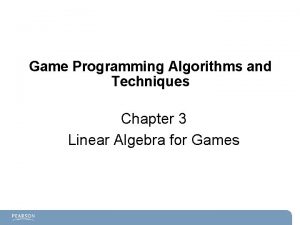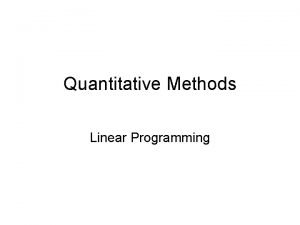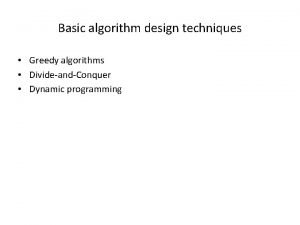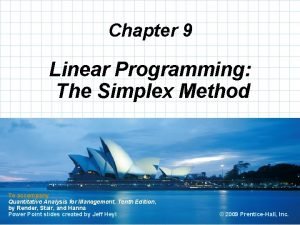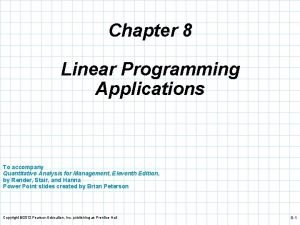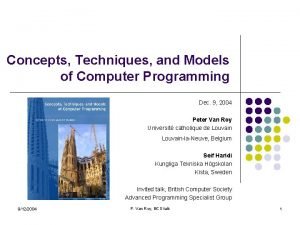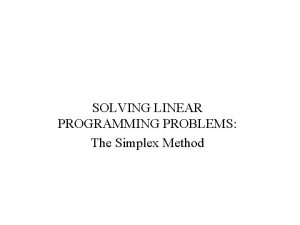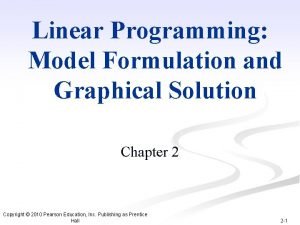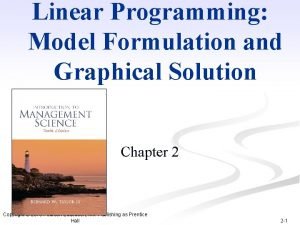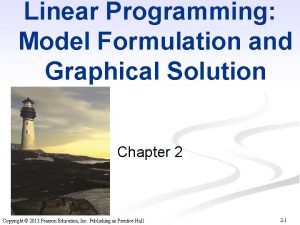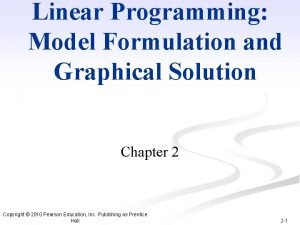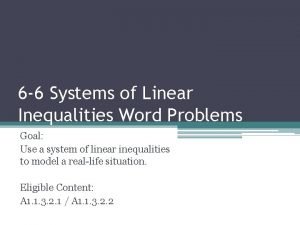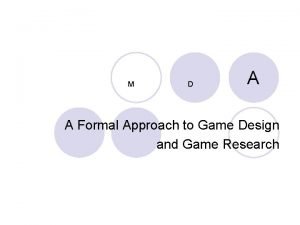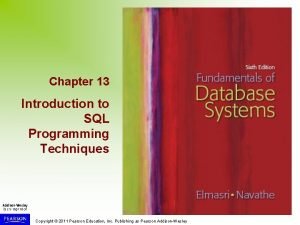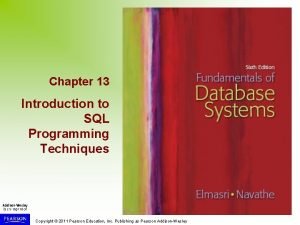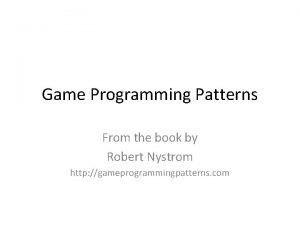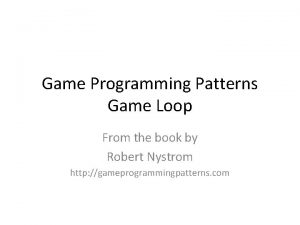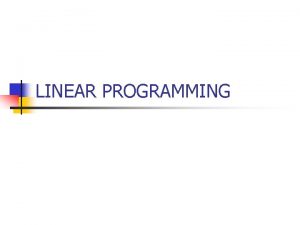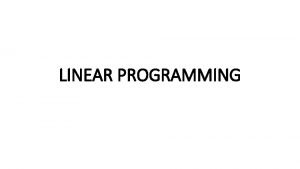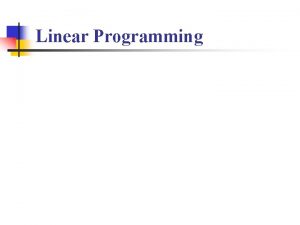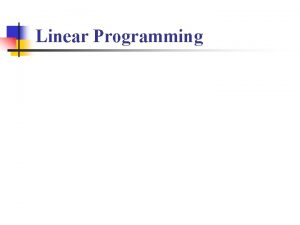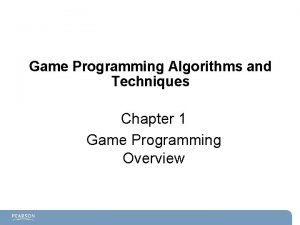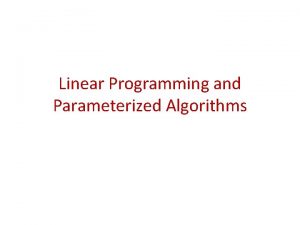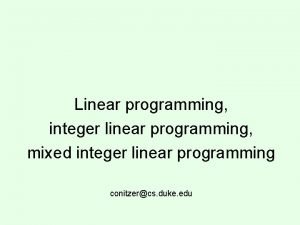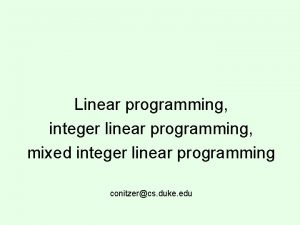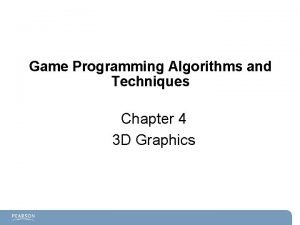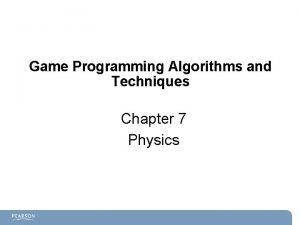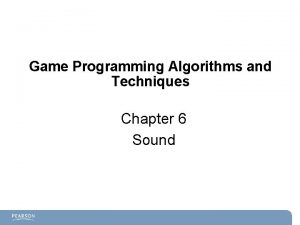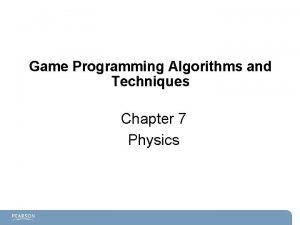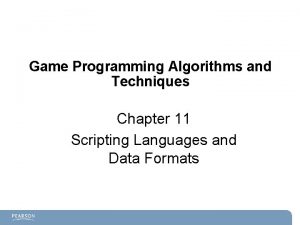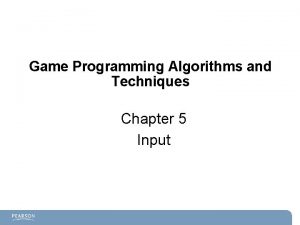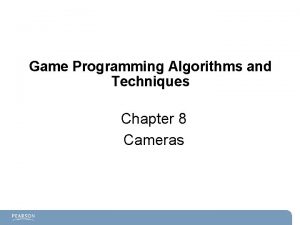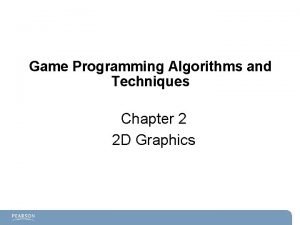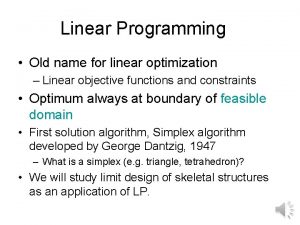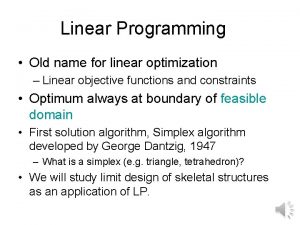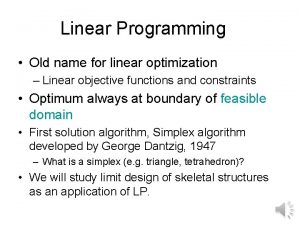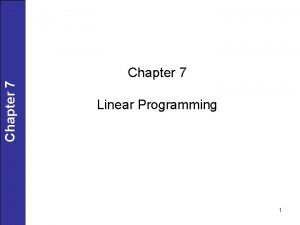Game Programming Algorithms and Techniques Chapter 3 Linear































- Slides: 31

Game Programming Algorithms and Techniques Chapter 3 Linear Algebra for Games

Chapter 3 Objectives § Vectors – Learn the fundamentals of vectors – Learn the two products (dot and cross) and their uses – Apply them to sample problems – Learn about different coordinate systems § Matrices – Learn how to multiply matrices – Transforming vectors by matrices

Vector Definition § Represents a magnitude and direction in n-dimensional space, with one real number per dimension: – For games, usually 2 D or 3 D vectors, though sometimes we use 4 D in 3 D games. § Expressed as: § No concept of position!

Vectors: No Position § § Where we draw a vector does not change its magnitude or direction, so it doesn't change the vector. These vectors all have the same value: Vector field where all the vectors are equivalent

Vector Terms § Tail: where the vector starts. § Head: what the arrow is "pointing at. " § Although where a vector is drawn doesn't change its value, it's helpful to draw with the tail starting at the origin.

Vector Drawn w/ Tail at Origin § The head "points at" the point that happens to correspond to the x and y component of the vector. The 2 D vector � 1, 2�drawn with its tail at the origin and its head “pointing at” (1, 2)

Addition Vector addition and the parallelogram rule § Is commutative.

Subtraction Vector subtraction § From A to B is B – A.

Subtraction: From Point A to B § Represent points A and B as vectors drawn with their tails at the origin: Representing points as vectors from the origin § Useful for a waypoint arrow, for example, which points from the player to the target.

Length and Length Squared § To calculate the length (or magnitude) of a vector: § If we just need a comparison between the length of two vectors, avoid the square root by using length squared:

Unit Vectors and Normalization § § Unit vectors have a length of 1. Drawn with a hat, like To convert a non-unit vector to a unit one, normalize the vector: Normalizing loses magnitude: – If you care about magnitude, don't normalize. – If you only care about direction, do normalize.

Scalar Multiplication Scalar multiplication

Dot Product § Allows you to figure out the angle between two vectors: Angle between unit vectors

Scalar Projection § Works with a normalized an unnormalized vector Scalar projection

Dot Product Special Cases (For Normalized Vectors) § 0 = Two vectors are perpendicular. § 1 = Two vectors are parallel and facing in the same direction. § -1 = Two vectors are parallel and facing in the opposite direction.

Dot Product Properties § Commutative, distributed over addition, and associative: § Length squared is the same thing as dot product with self:

Problem: Vector Reflection Steps to solve vector reflection

Vector Reflection Solution

Cross Product § § Only works with 3 D vectors Finds the vector perpendicular to the plane that contains a and b Cross product

"xyzzy" Mnemonic § Tells the subscripts of the first row: § Then rotate components in the order x -> y -> z -> x to get the next two rows:

Cross Product Properties § Is anti-commutative: § If the result of the cross product has 0 for every component, it means the two vectors are parallel.

Normal to a Triangle § Vector that is perpendicular to the triangle: The normal going into the page for triangle ABC (in a right-handed coordinate system)

Problem: Rotating a 2 D Character § How do you know if you turn clockwise or counterclockwise? The player needs to rotate to face the explosion.

Linear Interpolation Lerp from a to b with different f values

Coordinate Systems § Which coordinate system you choose is arbitrary, but must be consistent! Sample right-handed (a) and left-handed (b) coordinate systems

Matrices § A matrix is a grid of real numbers with m rows and n columns. § For games, 3 x 3 or 4 x 4 matrices are the most common.

Matrix Multiplication § Matrices A and B can be multiplied if the number of columns in A are equal to the number of rows in B:

Identity Matrix § Multiplying a matrix by the identity matrix does not change its value: § Number of rows/columns in I is equal to the number of columns in A: § If a matrix is multiplied by its inverse, the result is identity:

Transposing a Matrix § Rows become columns:

Representing a Vector as a Matrix § § § You can use either row-major or column-major. It doesn't matter which you select, but be consistent (most engines use row-major). Row-major: § Column-major:

Multiply a Vector by a Matrix § If you change from row-major to column-major (or vice versa), you must transpose the matrix:
 Game programming algorithms and techniques
Game programming algorithms and techniques Perbedaan linear programming dan integer programming
Perbedaan linear programming dan integer programming Linear vs integer programming
Linear vs integer programming Definisi integer
Definisi integer Non negativity constraints
Non negativity constraints Computational thinking algorithms and programming
Computational thinking algorithms and programming Synchronization algorithms and concurrent programming
Synchronization algorithms and concurrent programming Design techniques of algorithms
Design techniques of algorithms What cj-zj represents
What cj-zj represents Chapter 7 linear programming solutions
Chapter 7 linear programming solutions Chapter 8 linear programming applications solutions
Chapter 8 linear programming applications solutions Concepts, techniques and models of computer programming
Concepts, techniques and models of computer programming Simplex method problem
Simplex method problem Linear programming model formulation and graphical solution
Linear programming model formulation and graphical solution Linear programming model formulation and graphical solution
Linear programming model formulation and graphical solution What is a linear programming model
What is a linear programming model Lp model formulation example
Lp model formulation example Two variable inequality word problems worksheet
Two variable inequality word problems worksheet Greedy programming vs dynamic programming
Greedy programming vs dynamic programming What is system program
What is system program A formal approach to game design and game research
A formal approach to game design and game research Tentpoling
Tentpoling Introduction to sql programming techniques
Introduction to sql programming techniques Introduction to sql programming techniques
Introduction to sql programming techniques Game programming patterns robert nystrom
Game programming patterns robert nystrom Texture in game programming
Texture in game programming Game loop pattern
Game loop pattern Fonctions et solutions techniques
Fonctions et solutions techniques Simple linear regression and multiple regression
Simple linear regression and multiple regression Linear texts
Linear texts Non linear literature
Non linear literature Linear pipelining in computer architecture
Linear pipelining in computer architecture
